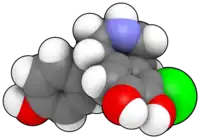 | |
 | |
| Clinical data | |
|---|---|
| Trade names | Corlopam |
| AHFS/Drugs.com | Monograph |
| Routes of administration | IV |
| ATC code | |
| Legal status | |
| Legal status |
|
| Pharmacokinetic data | |
| Metabolism | Hepatic (CYP not involved) |
| Elimination half-life | 5 minutes |
| Excretion | Renal (90%) and fecal (10%) |
| Identifiers | |
| |
| CAS Number | |
| PubChem CID | |
| IUPHAR/BPS | |
| DrugBank | |
| ChemSpider | |
| UNII | |
| KEGG | |
| ChEBI | |
| ChEMBL | |
| CompTox Dashboard (EPA) | |
| Chemical and physical data | |
| Formula | C16H16ClNO3 |
| Molar mass | 305.76 g·mol−1 |
| 3D model (JSmol) | |
| Chirality | Racemic mixture |
| |
| |
| | |
Fenoldopam mesylate (Corlopam) is a drug and synthetic benzazepine derivative which acts as a selective D1 receptor partial agonist.[1] Fenoldopam is used as an antihypertensive agent.[2] It was approved by the Food and Drug Administration (FDA) in September 1997.[3]
Indications
Fenoldopam is used as an antihypertensive agent postoperatively, and also intravenously (IV) to treat a hypertensive crisis.[4] Since fenoldopam is an intravenous agent with minimal adrenergic effects that improves renal perfusion, in theory it could be beneficial in hypertensive patients with concomitant chronic kidney disease.[5] It can cause reflex tachycardia, but it is dependent on the infusion of the drug.
Pharmacology
Fenoldopam causes arterial/arteriolar vasodilation leading to a decrease in blood pressure by activating peripheral D1 receptors.[6] It decreases afterload and also promotes sodium excretion via specific dopamine receptors along the nephron. The renal effect of fenoldopam and dopamine may involve physiological antagonism of the renin-angiotensin system in the kidney.[7] In contrast to dopamine, fenoldopam is a selective D1 receptor agonist with no effect on beta adrenoceptors, although there is evidence that it may have some alpha-1 [8] and alpha-2 adrenoceptor antagonist activity.[6] D1 receptor stimulation activates adenylyl cyclase and raises intracellular cyclic AMP, resulting in vasodilation of most arterial beds, including renal, mesenteric, and coronary arteries.[9] to cause a reduction in systemic vascular resistance. Fenoldopam has a rapid onset of action (4 minutes) and short duration of action (< 10 minutes) and a linear dose–response relationship at usual clinical doses.[10]
Side effects
Adverse effects include headache, flushing, nausea, hypotension, reflex tachycardia, and increased intraocular pressure.[4][11]
Contraindications, warnings and precautions
Fenoldopam mesylate contains sodium metabisulfite, a sulfite that may rarely cause allergic-type reactions including anaphylactic symptoms and asthma in susceptible people. Fenoldopam mesylate administration should be undertaken with caution to patients with glaucoma or raised intraocular pressure as fenoldopam raises intraocular pressure.[11] Concomitant use of fenoldopam with a beta-blocker should be avoided if possible, as unexpected hypotension can result from beta-blocker inhibition of sympathetic-mediated reflex tachycardia in response to fenoldopam.[11]
References
- ↑ Grenader A, Healy DP (July 1991). "Fenoldopam is a partial agonist at dopamine-1 (DA1) receptors in LLC-PK1 cells". The Journal of Pharmacology and Experimental Therapeutics. 258 (1): 193–198. PMID 1677038.
- ↑ Oliver WC, Nuttall GA, Cherry KJ, Decker PA, Bower T, Ereth MH (October 2006). "A comparison of fenoldopam with dopamine and sodium nitroprusside in patients undergoing cross-clamping of the abdominal aorta". Anesthesia and Analgesia. 103 (4): 833–840. doi:10.1213/01.ane.0000237273.79553.9e. PMID 17000789. S2CID 23684353.
- ↑ "Drugs@FDA: FDA-Approved Drugs". www.accessdata.fda.gov. Retrieved November 14, 2011.
- 1 2 Shen H (2008). Illustrated Pharmacology Memory Cards: PharMnemonics. Minireview. p. 9. ISBN 978-1-59541-101-3.
- ↑ Szymanski MW, Richards JR (2021). "Fenoldopam". StatPearls. Treasure Island (FL): StatPearls Publishing. PMID 30252314. Retrieved 2021-05-02.
- 1 2 Nichols AJ, Ruffolo RR, Brooks DP (June 1990). "The pharmacology of fenoldopam". American Journal of Hypertension. 3 (6 Pt 2): 116S–119S. doi:10.1093/ajh/3.6.116s. PMID 1974439.
- ↑ Gildea JJ (January 2009). "Dopamine and angiotensin as renal counterregulatory systems controlling sodium balance". Current Opinion in Nephrology and Hypertension. 18 (1): 28–32. doi:10.1097/MNH.0b013e32831a9e0b. PMC 2847451. PMID 19077686.
- ↑ Martin SW, Broadley KJ (May 1995). "Renal vasodilatation by dopexamine and fenoldopam due to alpha 1-adrenoceptor blockade". British Journal of Pharmacology. 115 (2): 349–355. doi:10.1111/j.1476-5381.1995.tb15884.x. PMC 1908310. PMID 7670737.
- ↑ Hughes AD, Sever PS (1989). "Action of fenoldopam, a selective dopamine (DA1) receptor agonist, on isolated human arteries". Blood Vessels. 26 (2): 119–127. doi:10.1159/000158760. PMID 2474340.
- ↑ Epstein, Murray MD, "Diagnosis and Management of Hypertensive Emergencies," clinical Cornerstone. Hypertension Vol2. No 1.
- 1 2 3 "Corlopam RA06497-R1-9/03 brand of Fenoldopam Mesylate Injection, USP" (PDF). NDA 19-922/S-005.